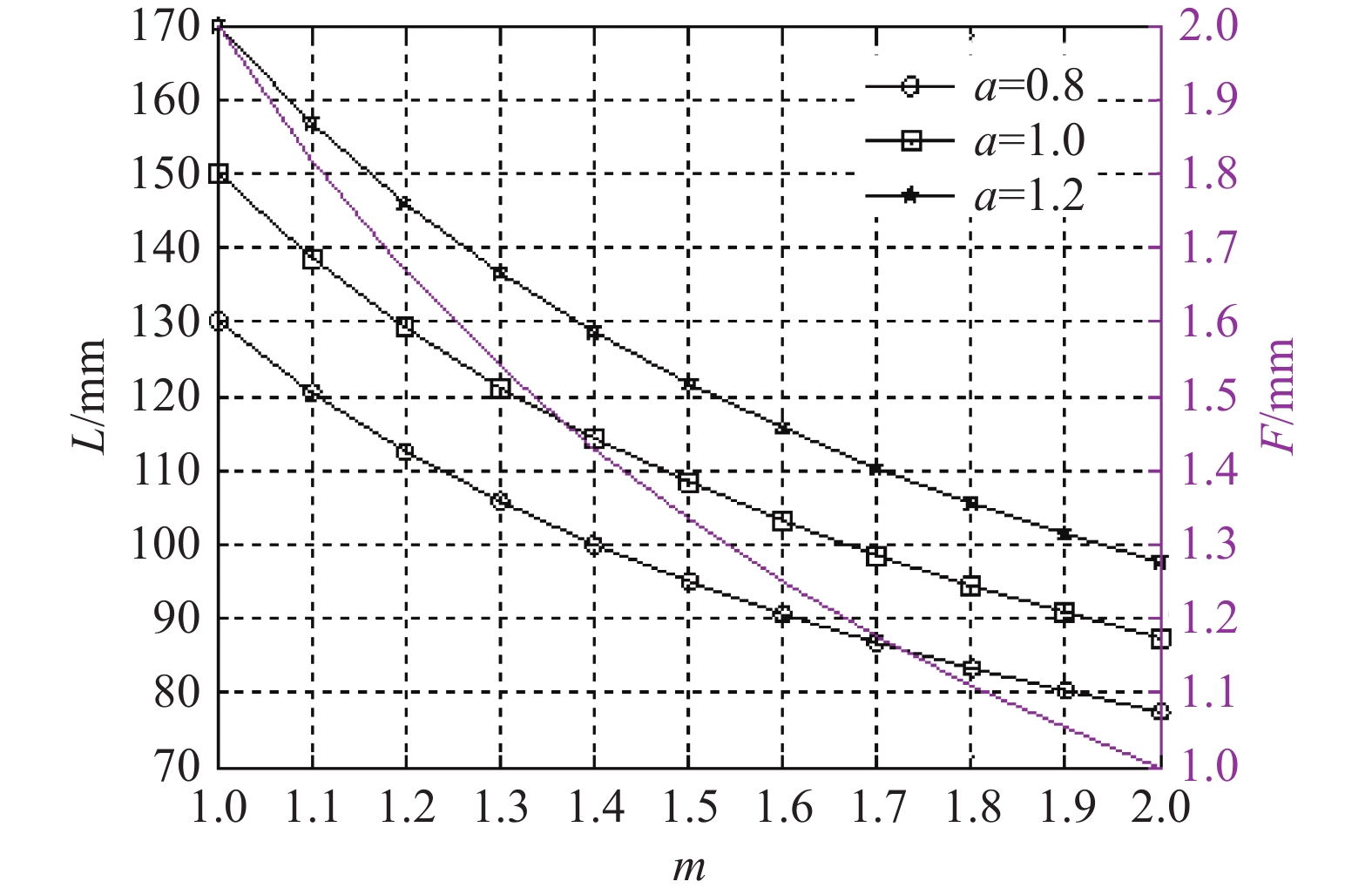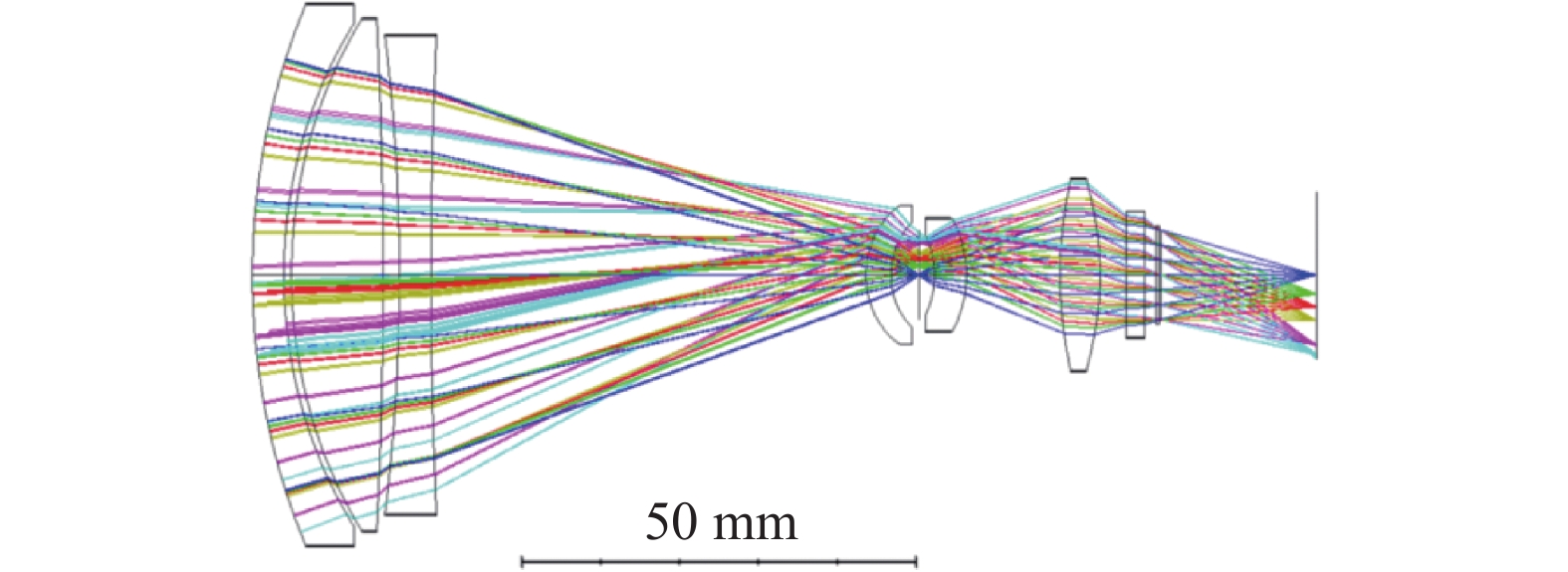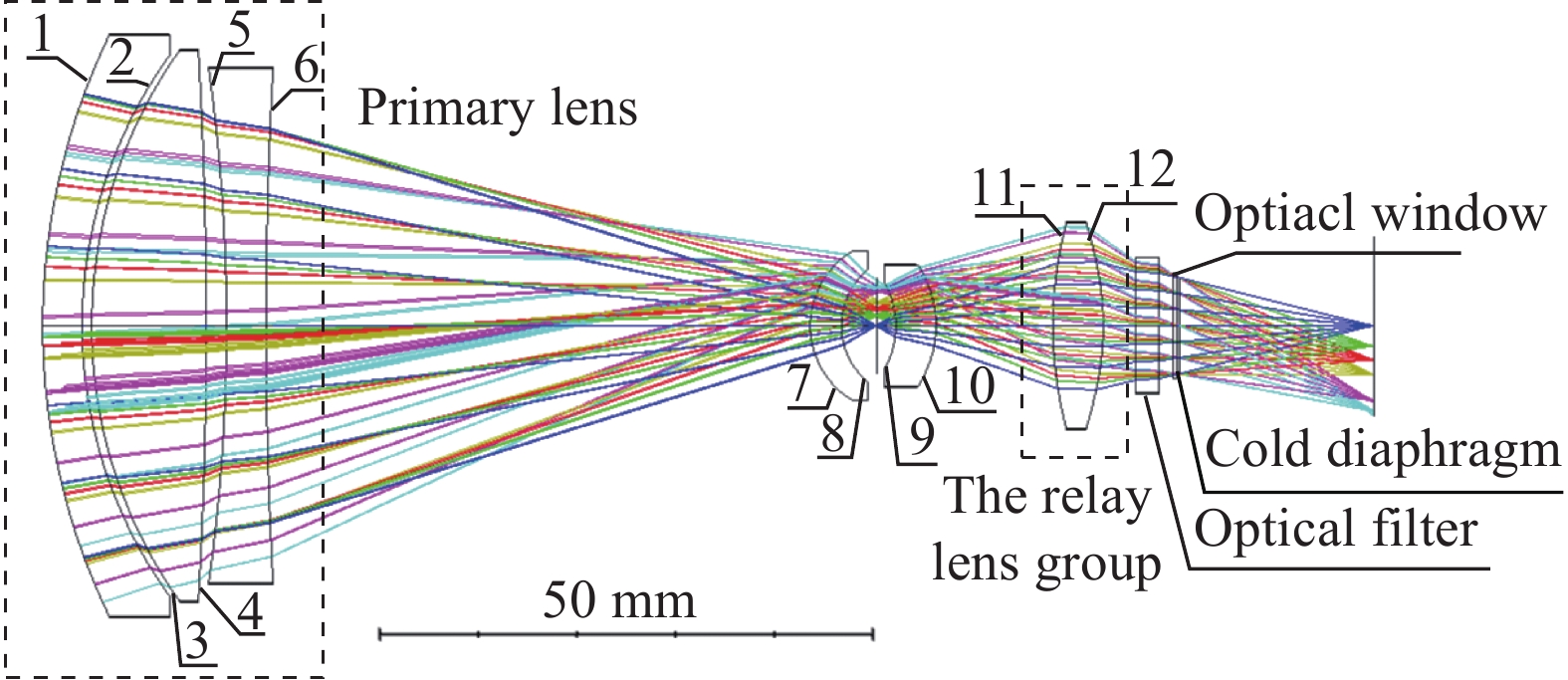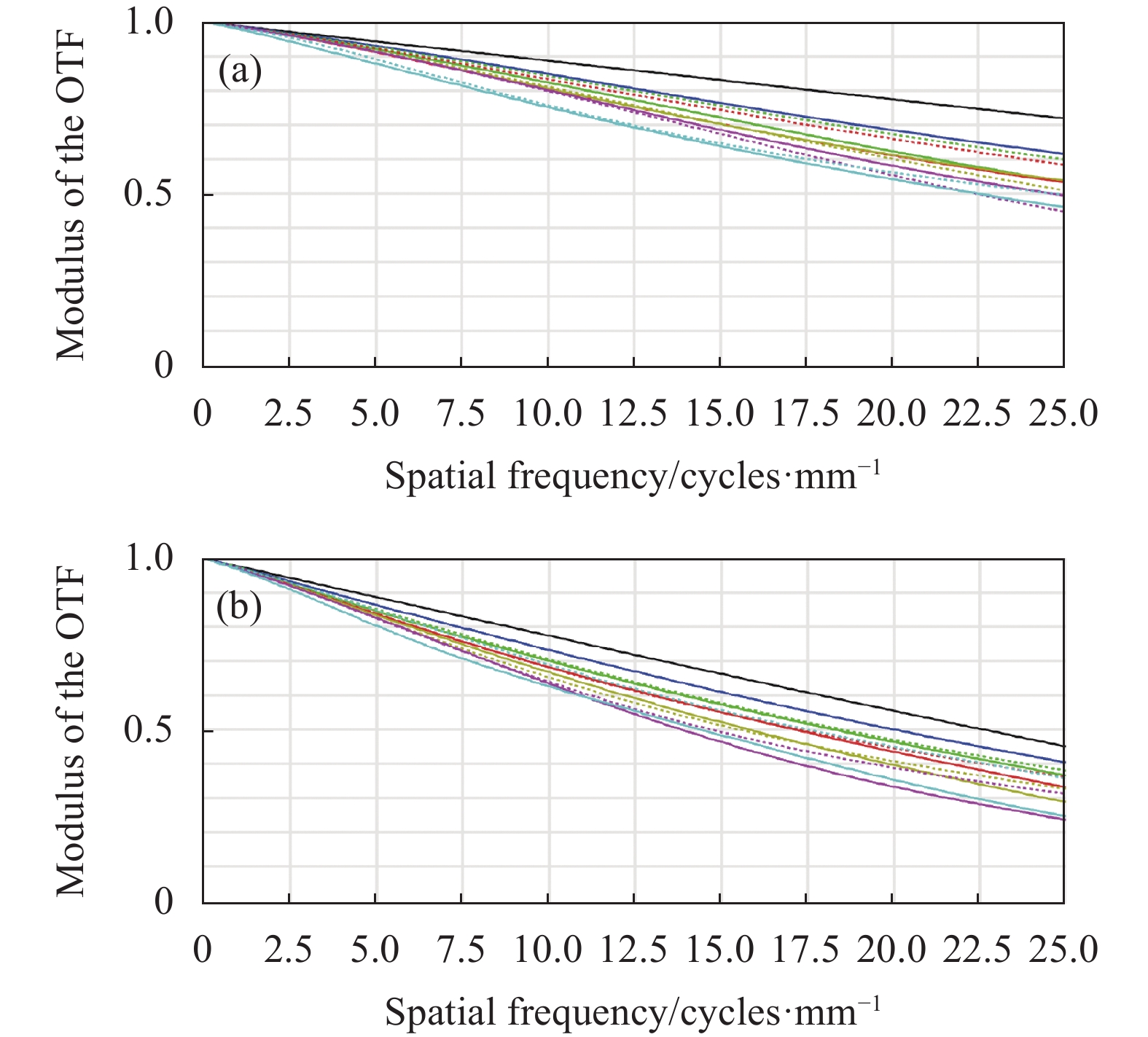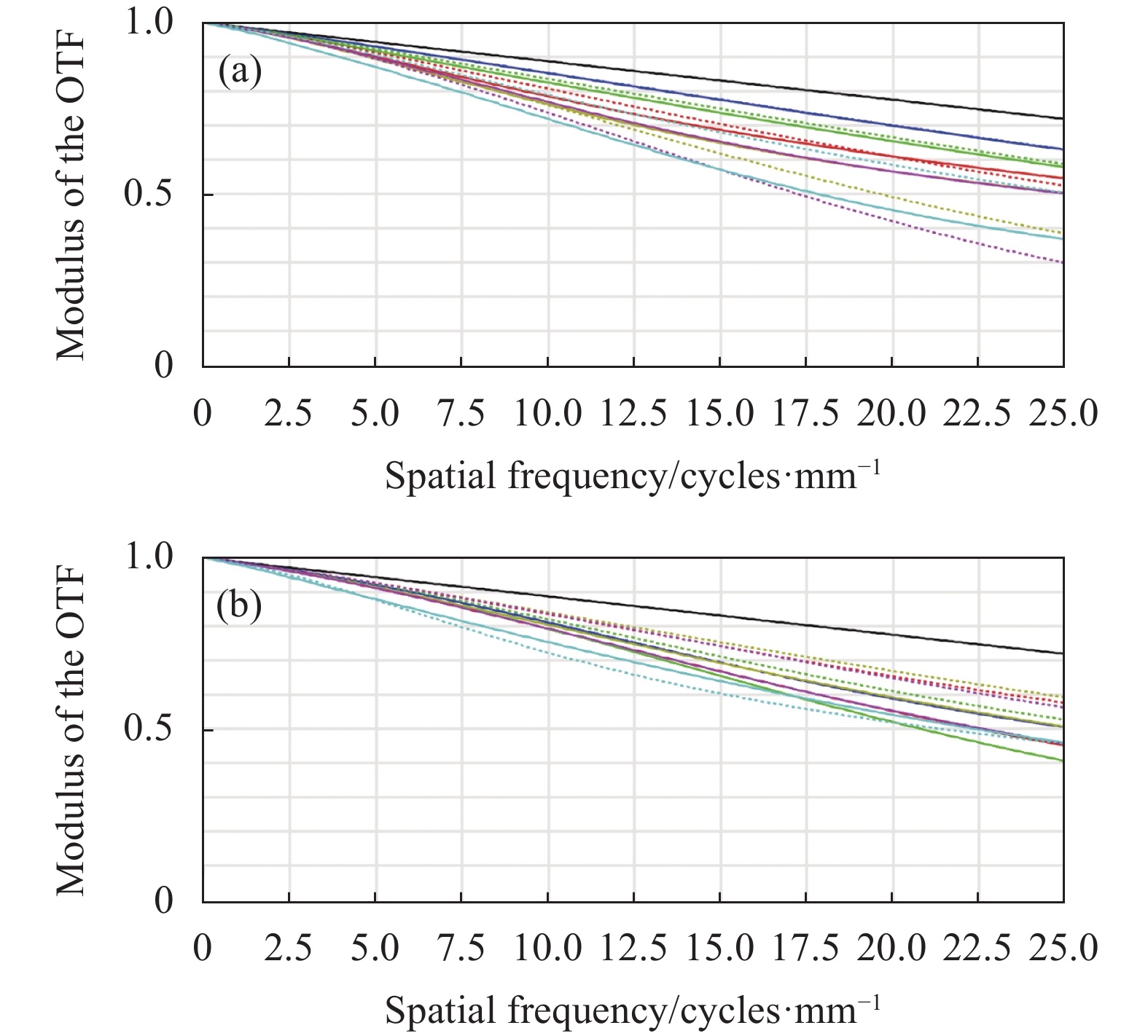-
共光路双波红外系统因其结构紧凑、抗干扰能力强而备受关注[1−6],然其光学设计往往有着严格的尺寸限制,且需要在小型化要求的前提下实现宽光谱消色差和被动无热化设计。早期及至近年,人们多采用衍射透镜的负色散特性和低膨胀系数进行色/热差矫正[7−14],新型光学元件的采用虽然在某种程度上改进了光学设计,取得了结构简单、紧凑的设计结果,但同时也会带来一些新的问题,如衍射透镜一般加工难度大、效率低、且会引入非工作级次杂光等;其色散特性在中波和长波两个波段上相同,且与材料本身特性无关,而系统中其他非衍射透镜的色散特性在中、长两个波段上不同,且与材料本身特性有关,这将使得系统像差,尤其是色差校正变得复杂。得益于新型硫系材料[15]的发展,解决了红外宽波段材料较少的问题。通过上述手段,红外双光光学系统的小型化有了进一步的提升。2022年,长春理工大学的田晓航设计了一款小F数红外双波段无热化折衍摄远物镜[16],F 数为 1.1,焦距为 75 mm,光学系统长度为105.35 mm,镜焦比(即光学系统长度与焦距之比)为1.405;2023年,中国航空工业集团公司洛阳电光设备研究所的黄辰旭设计了一款双波段透射式红外光学系统[17],焦距为320 mm,F数为2,光学系统长度为480 mm,镜焦比为1.5。为实现基于传统折射元件的小型化双波共光路设计,文中采用不同材料的透镜组合进行色/热差消除[17−19],利用高斯光学和初级像差理论,研究小型化设计的光学指标分配及像差校正特点,给出适配材料组合及色、热、球差和二级光谱矫正方法,最后通过实例对提出的小型化设计思想进行验证,开展成像质量优良、小型、温度不敏感的中长波共光路光学系统优化设计。
-
为保证100%冷光阑效率,制冷红外光学系统通常将光学系统的出瞳匹配探测器的冷光阑[20−22]。一次成像系统的结构形式简单,但其入瞳远离主镜,主镜尺寸较大,而二次成像结构可使入瞳位于主镜附近,主镜口径小,较适合使用在小型化平台上。二次成像结构形式示意图如图1所示,一般由主镜组(Primary lens)、中继镜组(The relay lens group)和冷光阑(Cold diaphragm)等组成。定义$ f $为系统焦距,$ {f}_{1} $为主镜组焦距, L为光学系统总长,L1为中继镜组(Relay lens)的物距,L2为中继镜组的像距。
结合高斯公式,可知该光学系统的筒长与镜焦比成正比,与中继镜组放大倍率成反比,并建立该光学系统的指标分配模型如下:
式中:$ m $为中继镜组放大倍率;$ \alpha $为主镜组镜焦比。
由于该系统所用制冷型红外探测器的感光面距离冷光阑有距离为19.7 mm,中继镜与冷光阑距离较近,为方便定量分析,可令$ {L}_{2} > 20 $ mm。为直观化上述光学指标分配模型,分别取主镜镜焦比$ \alpha $=0.8、1.0、1.2,中继镜组放大率$ m $从1变化到2,得到$ m、L、\alpha $之间的限制关系,如图2所示。
可以看出,随着中继镜组放大倍率增加,光学系统总长减小;同一中继镜组放大倍率下,通过减小主镜组的镜焦比,光学系统总长也减小。因此,可以通过从增大中继镜组放大倍率$ m $和减小主镜镜焦比$ \alpha $的角度考虑减少光学系统总长。但也可以看到,随着中继镜组放大倍率增加,主镜F数变小。当m增加到2时,主镜F数降到1。由像差理论可知,各单色像差均与系统的F数有关,F数越小,反而将系统复杂化,难以减小尺寸,主镜F数以不小于1为宜。
-
上述分析得到在系统约束条件下理想光学系统结构特点,然而实际光学系统中不可避免地存在差与色差,且红外光学系统特殊的热效应会引起不同温度下像面的位移,因此接下来对该光学系统进行像差分析与无热化设计。
根据初级像差理论,光学系统的球差、色差、二级光谱公式[23]如下:
式中:$ \dfrac{{n}_{F}-{n}_{D}}{{n}_{F}-{n}_{C}} $为相对色散,符号定义为P。
在该光学系统中,根据像差理论可知,主镜边缘光线较高,承担主要的球差、色差、二级光谱等系统像差,为实现消像差目的,必须对主镜的像差进行平衡。由于主镜与中继镜组光焦度均为正,根据公式(6)可知,正透镜组不能实现消色差,必须引入负光焦度透镜。负光焦度透镜的引入应尽可能多地贡献色散系数,尽可能少地贡献光焦度,原正光焦度主镜更多地贡献正光焦度,少贡献色散系数,这就要求负镜材料具备小阿贝数(符号为$ V $),正镜材料具有大阿贝数。表1列出了几种红外材料在双波段范围的光学特性,角标中的f、d、c有如下对应关系:f=3.7 μm,c=9.5 μm波长,d=4.8、7.7 μm。从表1中可以看出,ZnS材料的阿贝数最小,约为其他红外材料的1/4,较适合选为负镜材料。而除ZnSe、IRG208外,其余材料均比较适合选作正镜。
Materials $ {\mathit{N}}_{\mathit{f}} $ $ {\mathit{N}}_{\mathit{d}} $ $ {\mathit{N}}_{\mathit{c}} $ $ {\mathit{P}}_{\mathit{d}} $ $ {\mathit{V}}_{\mathit{d}} $ d=4.8 μm d=7.7 μm d=4.8 μm d=7.7 μm d=4.8 μm d=7.7 μm IRG201 2.513855 2.510236 2.502922 2.497732 0.224495 0.678092 93.66783 93.21424 IRG202 2.511224 2.507694 2.500724 2.495913 0.23056 0.685739 98.46816 98.01298 IRG203 2.607391 2.603005 2.594223 2.588077 0.227079 0.681755 82.9957 82.54102 IRG204 2.786165 2.781418 2.773711 2.769073 0.277744 0.728621 104.2225 103.7716 IRG205 2.62355 2.619273 2.610849 2.605094 0.231726 0.688172 87.73343 87.27698 IRG206 2.796253 2.791509 2.783922 2.779417 0.281747 0.732413 106.4065 105.9559 IRG207 2.623095 2.619482 2.613569 2.609976 0.27538 0.726078 123.4498 122.9991 IRG208 2.418159 2.413559 2.40087 2.390473 0.166146 0.624467 51.05802 50.59969 IRG209 3.165434 3.15623 3.1459 3.141838 0.390086 0.827866 91.37959 90.94181 Germanium 4.029211 4.017606 4.007251 4.004855 0.476502 0.901649 123.8955 123.4703 ZnSe 2.434334 2.430243 2.418698 2.409392 0.164017 0.626893 57.34287 56.88 ZnS 2.254125 2.247816 2.22558 2.206207 0.13165 0.595696 26.04061 25.57656 Table 1. Optical properties of several infrared materials
在引入ZnS负镜后,主镜的色差得到平衡,然而根据公式(7),若靠“+、−”光焦度的镜头结构,既要消色差,又要消二级光谱,势必要求两种材料的相对色散相同,但由表1可知,所备选的宽波段红外材料其相对色散均比ZnS的略高,即+、−”光焦度的镜头结构主镜组的二级光谱将是一个正值,不能同时满足消色差和二级光谱的要求。因此,为消二级光谱,应在主镜附近再引入一片负镜,构成“−、+、−”结构,分析如下:主镜组各个镜片上光线高度接近,将光焦度、色差和二级色散公式展开得到如下公式[23]:
式中:$ {\varepsilon }_{1} $与$ {\varepsilon }_{2} $为小量值。结合表1中的材料特性,可令$ {\upsilon }_{1}={\upsilon }_{2}=4{\upsilon }_{3} $,联立公式(8)~(10),可近似得到如下关系式:
式中:$ \phi {、\phi }_{2} $均为正值。已选定的3镜ZnS其$ {P}_{3} $较小,为使上式能够趋于一个无穷小量 ,则要求$ {P}_{1} $比$ {P}_{2} $大,表1中Germanium 和IRG209的相对色散较大,通常采用铝合金作为镜筒材料,IRG209的膨胀系数与铝合金材料热膨胀系数相当,较适合作为另一片负镜的玻璃材料,用于矫正二级光谱,且不引入热差。
红外光学系统因热效应造成镜片及结构件热膨胀,会导致光学系统焦面随着温度漂移。目前国内外消热差常用以下三种方式:机械被动式消热差、电子主动式消热差以及光学被动式消热差。由于前两种方式均需依赖机械装置进行补偿,体积会随之变大,不利于整机小型化的实现,因此文中采用光学被动式消热差方法,利用光学材料热特性以及机械材料热特性进行光学补偿,进而减小热差引起的离焦,该方法无需引入补偿结构,有利于整机结构小型化的实现。消热差方程如下:
式中:$ {\chi }_{i} $为透镜光热膨胀系数;$ {\sigma }_{h} $为结构件材料的热膨胀系数;$ L $为机械结构长度。
-
为验证上述设计思想,选择某一特定的制冷中长红外共光路光学系统作为实例进行优化设计,其设计参数以及探测器指标如表2所示。
Index Parameter Working band/μm 3.7-4.8
7.7-9.5F-number 2 Focal length/mm 100 Field of view >6°×7° Efficiency of cold diaphragm 100% Temperature/℃ −40-60 Size of area array 640×512 Pixel/μm 20 Distance form cold diaphragm to detector/mm 19.7 Table 2. Design parameters of the optical system
系统采用二次成像透射式共光路结构,为实现光路结构紧凑,使光学系统后截距略大于探测器的光窗至光焦面的距离,根据表2中探测器冷光阑至焦面距离,近似地令$ {L}_{2}=20\;\mathrm{m}\mathrm{m},m $=2。根据表2得到系统F数为2,系统焦距为100 mm,结合光学系统参数中F数与系统焦距,$ D=50\;\mathrm{m}\mathrm{m}, $结合第1节公式得到主镜组$ F $数为1, $ {f}_{1}=50\;\mathrm{m}\mathrm{m},{L}_{1}=10\;\mathrm{m}\mathrm{m} $,当镜焦比为1.8时,L=120 mm。将设计值输入Zemax软件,根据分析得到的主镜结构关系,设定前三片镜片玻璃材料分别为IRG209、IRG202和ZnS,完成光路设计,最终得到的光学系统设计光路如图3所示,该光学系统主镜焦距为46.551 mm,主镜镜长为86.522 mm,光学系统总长L为134.9 mm,镜焦比为1.349。
-
光学系统总长134.9 mm,中继镜组放大倍率2.2,主镜组焦距46.5 mm,与设计分析相符。图4为光学系统镜组关系,该光路共六片镜片,主镜的三片镜片光线高度接近,第四、五片透镜靠近一次像面,用于偏折光线降低中继镜组光线高度和调整热离焦焦面位置,从而减弱其像差影响,并实现消热差设计。材料选择主要为Ge、ZnS与硫系玻璃;主镜材料选择后,光路仍有较大球差,若增加镜片平衡球差,会增加光路重量,且一定程度上拉长了光学系统,因此引入非球面。根据公式(5)可知,边缘光线高度越大,球差越大。根据初级相差理论可知,球差的矫正与彗差、像散成正相关,因此应在靠近光阑的镜片上设置非球面,最终在第10面、11面与12面上引入非球面,镜筒采用铝合金材料,其热膨胀系数为2.36×10−5mm/℃,优化后得到成像质量优良的中长红外共光路光学系统,长波后截距为19.8688 mm,中波后截距为19.8715 mm,相差0.0027 mm,满足共光路共焦面设计要求。
在工作温度范围内,中波、长波在奈奎斯特频率25 lp/mm处的调制传递函数(MTF)如表3所示。中波红外MTF在全温度范围内均大于0.42,长波红外MTF在全温度范围内均大于0.28,成像质量优异。图4为常温下中波红外与长波红外的MTF图。
MTF On the
optical axis
25 lp/mm0.7 field
of view
25 lp/mmFull field
of view
25 lp/mm20 ℃ 3.7-4.8 μm 0.62 0.47 0.48 7.7-9.5 μm 0.41 0.27 0.25 −40 ℃ 3.7-4.8 μm 0.58 0.42 0.48 7.7-9.5 μm 0.41 0.26 0.28 60 ℃ 3.7-4.8 μm 0.51 0.51 0.42 7.7-9.5 μm 0.42 0.30 0.28 Table 3. MTF of optical system
该共光路双波段小型红外光学系统的杂散光分析结果如图5与图6所示,由于该光学系统冷阑效率达到了100%,因此仅考虑光学系统内杂散光引起的冷反射。外壳与压圈隔圈作简化处理,相接的部分作一体化处理,近似将外壳内表面看作主要杂散光发出源,光源类型为面光源。热辐射强度主要与结构件温度和表面发射率有关,系统工作温度范围为−40~60 ℃,分别设置面光源温度为−40 ℃、20 ℃和60 ℃,发射面型为朗伯发射面型;设置外壳内表面发射率为0.98;根据光学系统仿真结果输入镜片材料参数,设置外壳镀膜参数。最终外壳内表面光源引起的光学系统杂散光在像面上的辐照度在−40 ℃时最大不超过5.3×10−9 W/m2,在20 ℃时最大不超过9.4×10−8 W/m2,图7显示了在60 ℃时,像面上杂散光辐照度最大不超过3.7×10−7 W/m2,均不会在像面上产生杂斑。
基于光路设计研制了样机,实测得到镜片参数、镜片间隔以及表面倾斜的实测公差数据,如表4所示。
Surface Radius/mm Thickness/mm Surface tilt/(°) 1 −0.032 −0.035 0.0007 2 0.003 −0.024 3 0.004 0.002 0.00562 4 −0.231 −0.066 5 −0.036 0.015 0.000504 6 0.026 0.001 7 0.002 0.016 0.0146 8 0.002 −0.086 9 −0.005 −0.006 0.00441 10 −0.001 0.038222 11 0.006 0.035 0.00584 12 0.031 0.022 Table 4. Measurement tolerance data of optical systems
将表4中数据输入到Zemax中,像质受到一定的影响。以常温下中波全视场MTF为例,从图8中可以看出,MTF从原本的0.48降至0.31。通过焦面补偿,将像面向前移动0.053 mm,最终得到的系统常温下中波全视场MTF为0.41,该系统具备加工条件。
-
文中基于高斯光学建立了光学指标分配模型,分析得到了系统筒长、放大倍率与镜焦比之间的限制关系;在此基础上进行像差分析与无热化设计,重点分析了主镜组球差、色差与二次像差的矫正方法,通过红外玻璃材料性质分析选定了高部分色散负镜、大阿贝数正镜以及小阿贝数负镜构成主镜的“−、+、−”结构;同时对该系统进行被动式无热化设计;最终在此研究基础上进行实例设计,得到系统参数如下的光学系统:工作波段3.7~4.8 μm、7.7~9.5 μm, F数为2,f=100 mm,视场角大于6°×7°,工作温度范围为−40~60 ℃。最终得到的光学系统成像质量优良,工作温度范围内中波MTF最低大于0.42,长波MTF最低大于0.28;长波后截距为19.8688 mm,短波后截距为19.8715 mm,相差0.0027 mm,镜焦比为1.349,满足共光路共焦面光学系统设计需求。后续将开展后组镜片的消像差能力研究,减少镜片和非球面使用数量。
Miniaturization analysis and design of the common-optical path dual-wave infrared optical lens
doi: 10.3788/IRLA20230722
- Received Date: 2023-12-27
- Rev Recd Date: 2024-03-07
- Publish Date: 2024-04-25
-
Key words:
- optical design /
- infrared dual band common optical path /
- aberration correction /
- stray light analysis
Abstract:



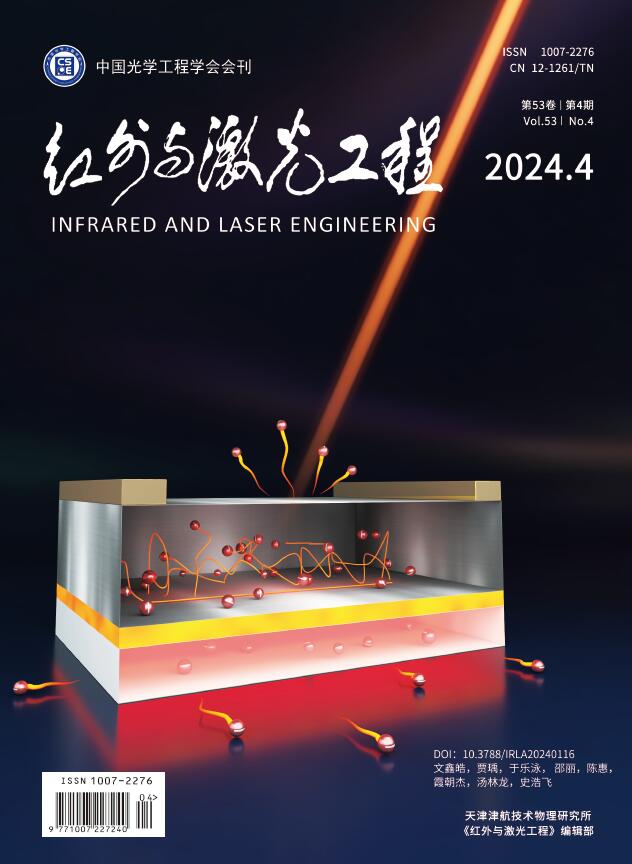






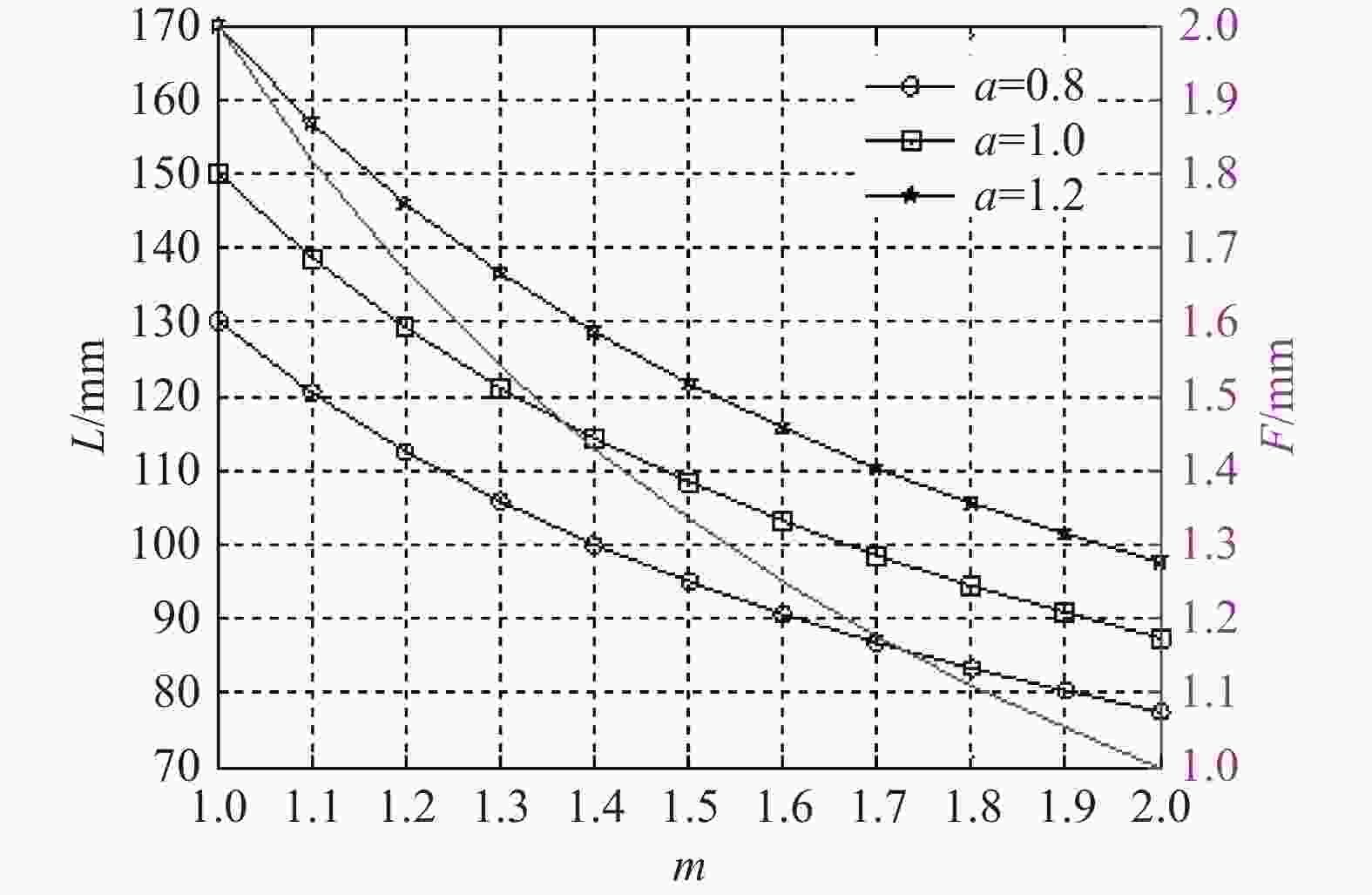
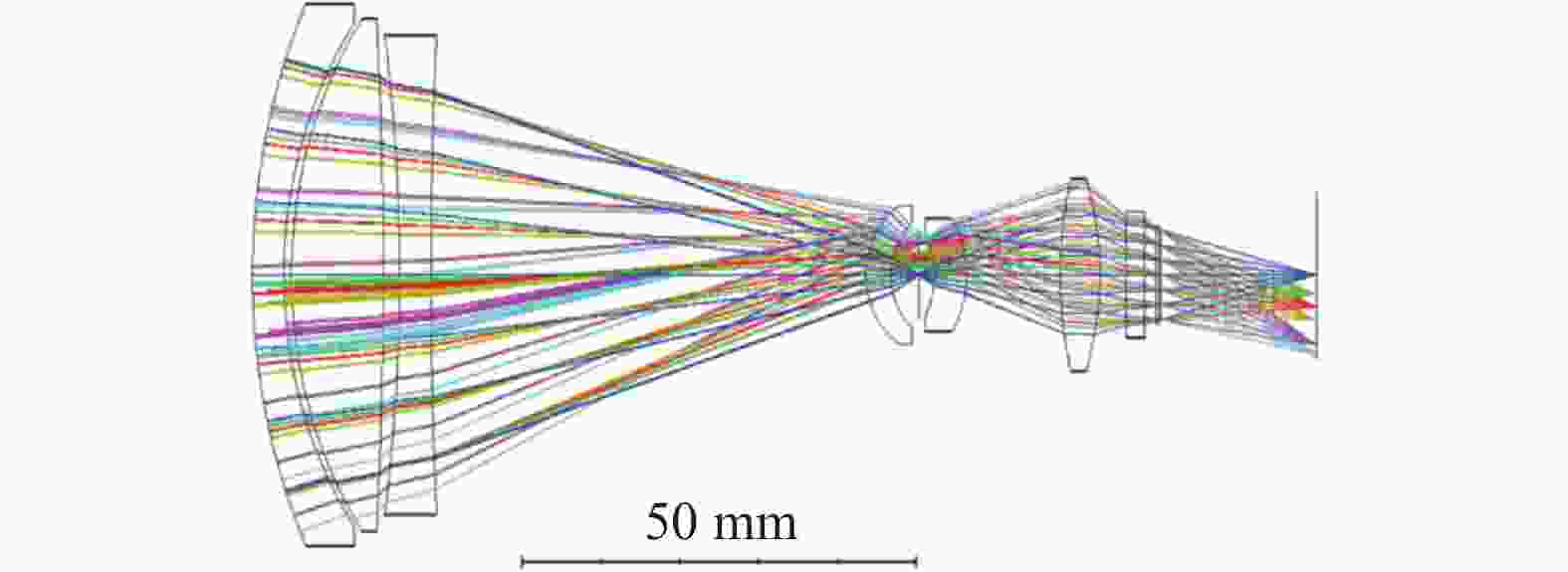
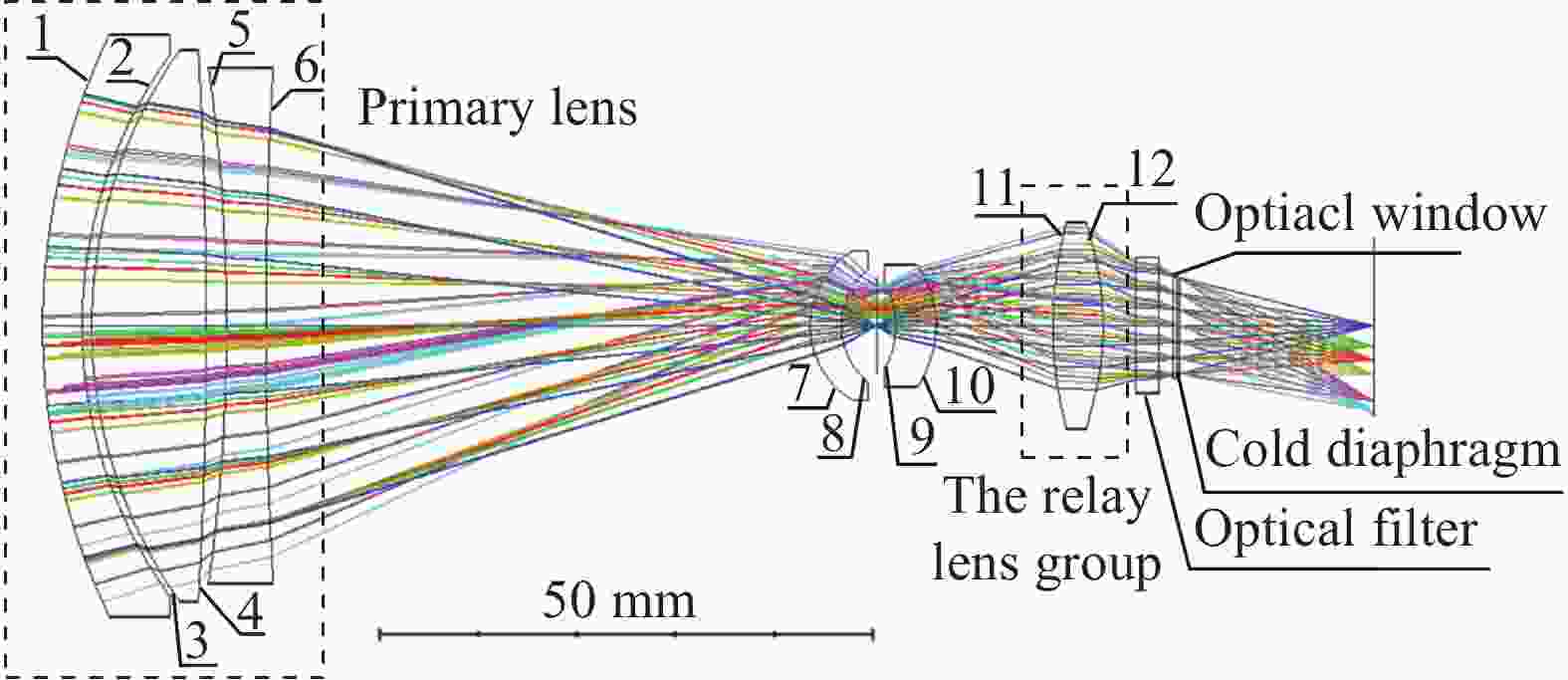
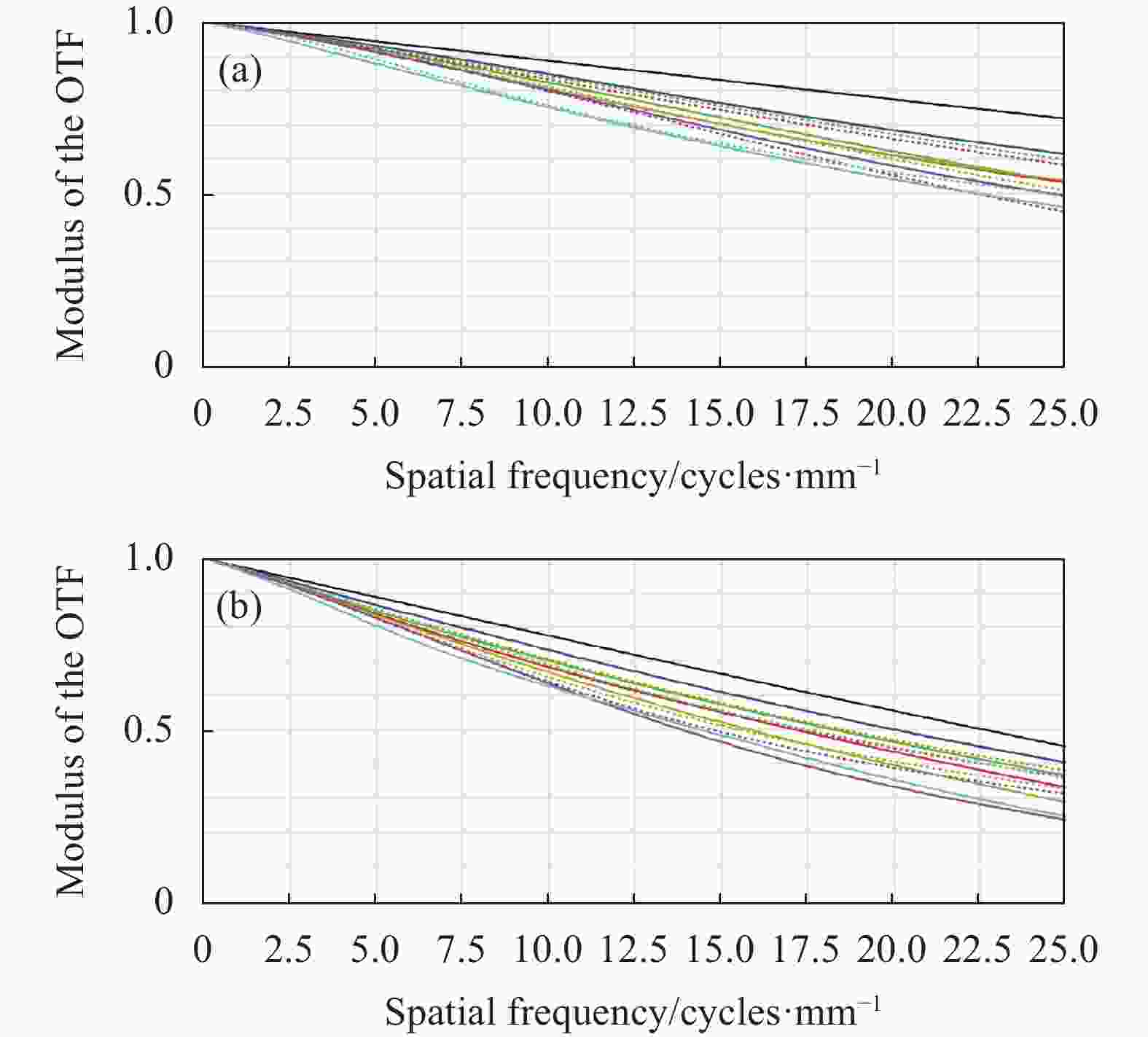


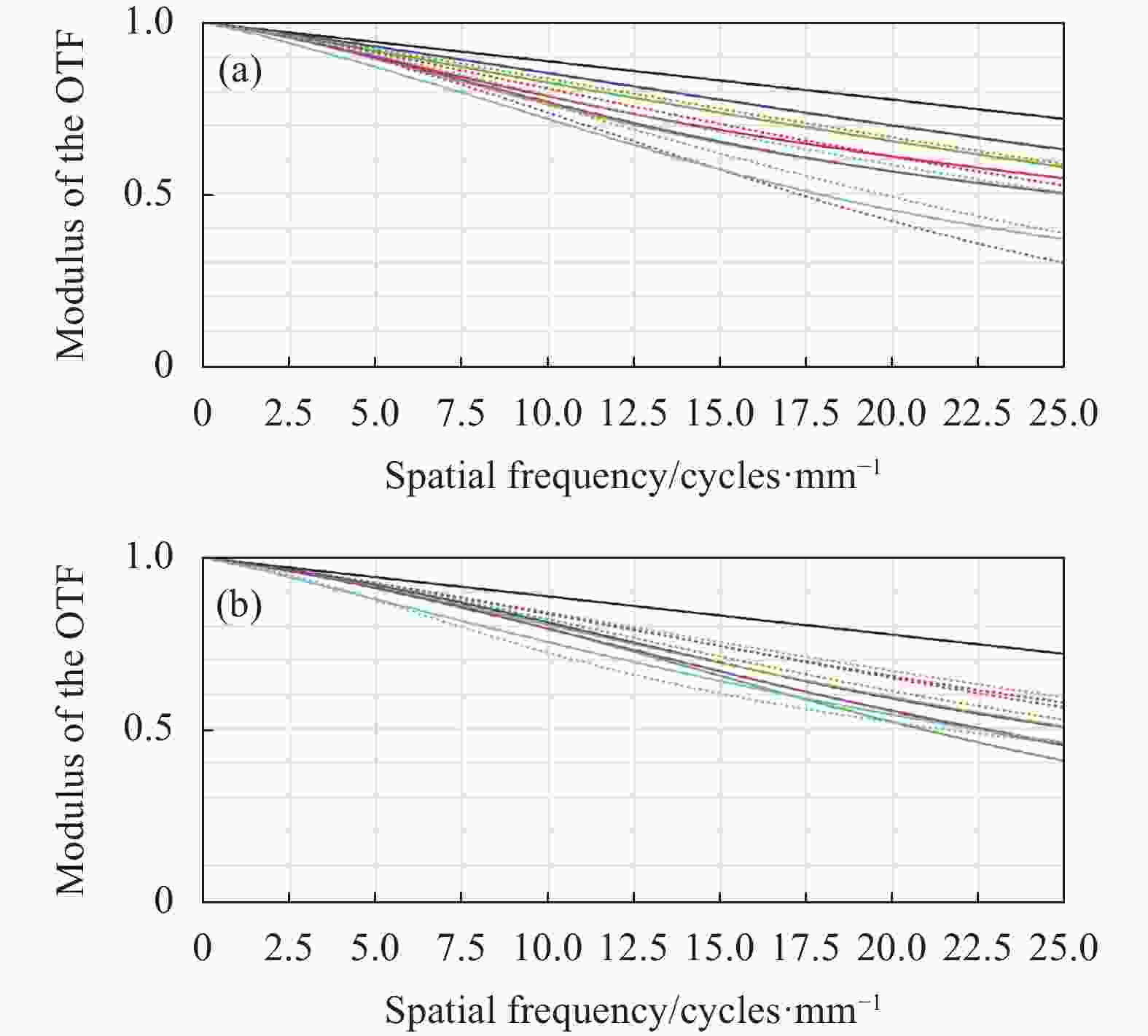

 DownLoad:
DownLoad:
